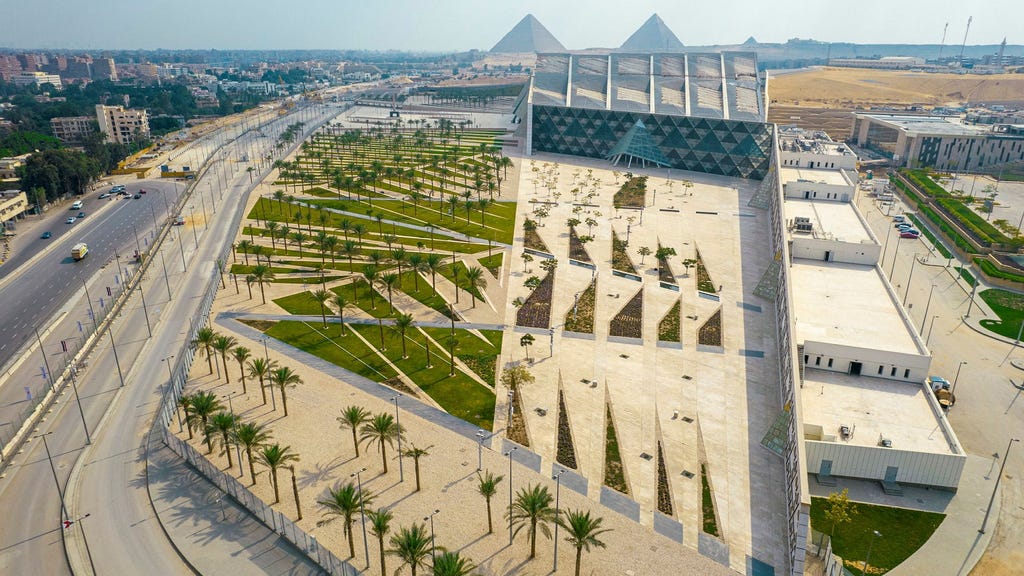King Tutankhamun’s treasures are on the move. For nearly a century, the boy king’s funerary belongings have captivated visitors at the Egyptian Museum in Cairo. Now, they await transfer to their new, grand home: The Grand Egyptian Museum (GEM), a colossal structure near the Giza pyramids poised to be the world’s largest archaeological museum. This move, however, is not just a logistical undertaking; it’s deeply intertwined with Egyptian national identity and political symbolism.
GEM, a sprawling 80,000 square meter behemoth, is a testament to both ancient grandeur and modern ambition. Its design, a juxtaposition of Pharaonic monumentality and contemporary shopping-mall aesthetics, reflects the tension between Egypt’s rich past and its aspirations for the future. From the colossal statue of Ramses II gracing the entrance hall to the theatrically lit galleries showcasing ancient artifacts, GEM promises a dramatic and immersive experience, culminating in a breathtaking view of the pyramids from its monumental staircase. This modern, visually stunning museum contrasts sharply with the cluttered displays and dimly lit corridors of the old Cairo museum, signifying a deliberate break from the past.
The delayed opening of GEM, initially slated for 2013, has been plagued by financial and political turmoil. The museum’s partial opening in October 2023, showcasing galleries spanning from the Neolithic period to the Hellenistic era, offers a glimpse into its potential. However, the full inauguration, including the unveiling of Tutankhamun’s complete collection, remains pending, seemingly contingent on factors beyond mere logistical concerns. The grand opening, whenever it occurs, will be a carefully orchestrated event laden with political significance, serving as a symbolic reclamation of Egypt’s heritage.
The construction of GEM is part of a larger national project aimed at reclaiming Egypt’s historical narrative from Western dominance. Egyptian archaeology, from its major discoveries to the academic discipline of Egyptology, has been largely shaped by Western scholarship. Many significant Egyptian artifacts reside in museums across Europe, and even prominent Egyptian museums, like the one in Cairo and the Greco-Roman Museum in Alexandria, are products of the colonial era. GEM represents a conscious effort to shift this paradigm, positioning Egypt as the rightful custodian of its own past.
This reclamation of historical narrative is echoed in other museum projects across Egypt. The Bibliotheca Alexandrina, a modern marvel built on the site of the ancient Library of Alexandria, stands as a symbol of renewed intellectual and cultural ambition. The renovated Greco-Roman Museum in Alexandria, with its dazzling light displays and modern aesthetics, further emphasizes this shift towards a visually compelling presentation of history. The Alexandria National Museum, while facing financial constraints, attempts to weave a cohesive national narrative, portraying Egypt’s diverse historical periods as interconnected stages of a continuous civilization.
The National Museum of Egyptian Civilization in Cairo, inaugurated in 2022, reinforces this narrative by presenting Egyptian history as a seamless continuum, culminating in a dramatic display of mummified pharaohs. The theatrical procession of these ancient rulers from the old museum to their new resting place, a spectacle orchestrated with Hollywood-esque flair, foreshadows the grand ceremony anticipated for Tutankhamun’s eventual move to GEM. These elaborate displays underscore the political undercurrent driving these museum projects, serving to legitimize the current regime as heirs to the ancient pharaohs. The new museums, while celebrating Egypt’s past, also serve as powerful tools for shaping its present and future. The grand projects, such as GEM and the new administrative capital rising in the desert, are not just about preserving history; they are about projecting an image of a modern, powerful Egypt, firmly rooted in its glorious past, yet boldly striding towards a new era. These ambitious undertakings, however, are not without their challenges, as evidenced by the financial strains and public discontent surrounding them. The question remains whether these grand visions will ultimately serve the Egyptian people or primarily bolster the image of those in power.














